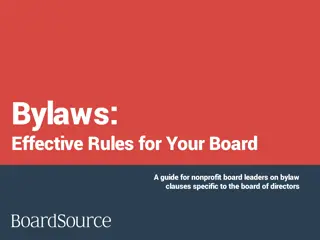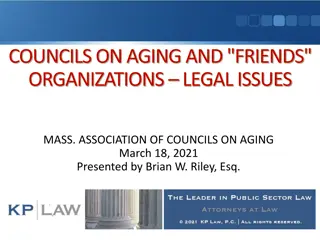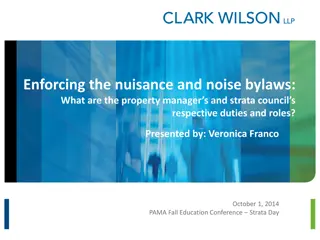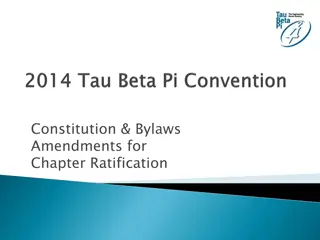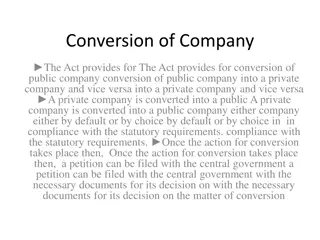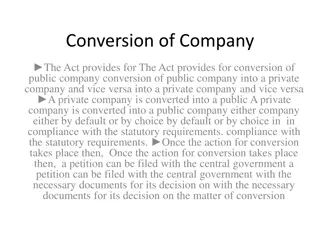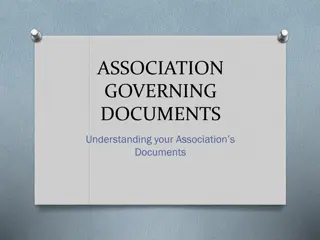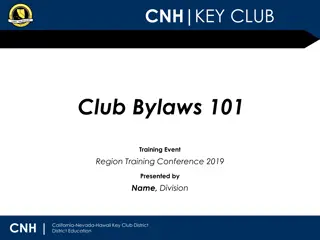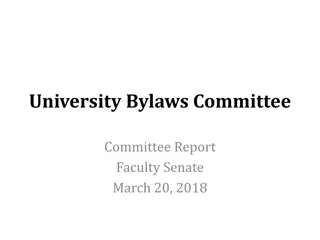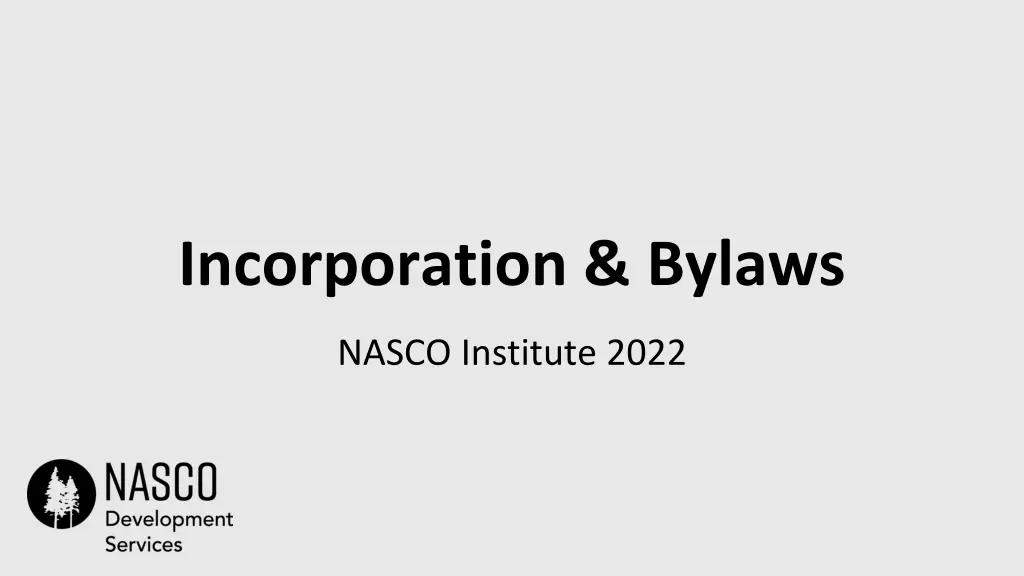
Incorporation and Bylaws: A Complete Guide for Co-ops
Discover the importance of incorporation and bylaws for cooperatives, including benefits, drafting tips, tax exemption advice, and the step-by-step process to legally establish your entity. Learn why incorporating is vital for the longevity and legal recognition of your co-op.
Download Presentation

Please find below an Image/Link to download the presentation.
The content on the website is provided AS IS for your information and personal use only. It may not be sold, licensed, or shared on other websites without obtaining consent from the author. If you encounter any issues during the download, it is possible that the publisher has removed the file from their server.
You are allowed to download the files provided on this website for personal or commercial use, subject to the condition that they are used lawfully. All files are the property of their respective owners.
The content on the website is provided AS IS for your information and personal use only. It may not be sold, licensed, or shared on other websites without obtaining consent from the author.
E N D
Presentation Transcript
Incorporation & Bylaws NASCO Institute 2022
Benefits of incorporation for co- ops Pro's and con's of different corporate forms Articles of Incorporation How to draft bylaws Overview What s included
Session Overview How to get tax exemption Specific advice for your state Actual legal advice get your own attorney! What s NOT included
Incorporation is the process by which a person or group of persons creates a new legal entity A Corporation . Definitions A Corporation is a legal entity that has legal rights and responsibilities. It can have debts and own things. Corporations are controlled by their Members or Shareholders.
Articles of Incorporation are a document filed with the government that defines and establishes the Corporation. Articles Definitions Bylaws define the rights and responsibilities of members or shareholders and define how the corporation is governed A Cooperative is a type of Corporation that is owned and democratically controlled by its members, with one vote per member.
Why Without Incorporating, your Co- op doesn t legally exist! Incorporate?
Creates an entity that can enter into contracts and own things What Does Incorporating Do? Allows the entity to last beyond your personal involvement Provides Limitations on personal liability
Preparation Steps Find a group of people Define a mission Research Corporate Structures and choose one Decide if you want tax exemption Incorporation Steps Draft Articles of Incorporation File Articles with the Government Draft Bylaws Draft Policies & Operating Documents Steps to Incorporation
3-5 people minimum People who will be committed to being part of the cooperative for 1+ years Core Group Easily reached (The Incorporators) Willing to sign & have their real address on a government document. *For more details on forming a Core Group, see Strategies for New Co-op Organizers , another of NASCO s Development Presentations.
Form Follows Function Define goals before incorporating. Ask yourselves: Why do I want this to be a co-op? Choose the structure that meets your needs. *For details on developing Mission Statements, see Strategies for New Co-op Organizers , another of NASCO s Development Presentations.
Articles of Incorporation are a document filed with the government that defines and establishes the Corporation. Definition In Canada, these may be filed Federally or Provincially. In the US, these are filed with a State.
Type of corporation Name of the corporation Names and signatures of Incorporators Registered Agent Membership of the corporation Purpose of the corporation How and when it can be dissolved. Key Parts
If you are incorporating in Canada, it s usually best to federally file as a nonprofit housing cooperative. Canada makes this relatively painless. Types of Corporation Corporations Canada s Site on how to create a cooperative: (Canada Specific Corporation types) Corporations Canada s Articles of Incorporation Filing form:
If youre in the U.S. It may be a bit trickier. You will have to organize in your state, and your state may have many different versions Types of Corporation C-Corp/S-Corp Charity/Nonprofit Cooperative B Corp LLC (U.S. Specific Corporation types)
Types of Corporation Not always Co-op Cooperatives are not always available as a corporation type in your area. In these cases you may have to choose another form of incorporation, and build your cooperative structure within that framework. For example: A traditional nonprofit corporation does not require that members be able to vote or choose the board, however, when incorporating a nonprofit, you could include those provisions in the bylaws of the organization.
Choosing A Name Clear Simple Unique Legal
Be aware of securities issues related to stock Interstate sales of stock is regulated to the SEC - very complicated Intrastate sales is not - BUT probably regulated by your State agency WI has total exemption for Coops. Stock vs Non- Stock (U.S. Specific)
Membership shares are not stock - if they are: What about Member Shares? One share per member only - and every member has one Do not entitle member to share of profits (different than member rebate) Can not be sold - can only be exchanged back to Coop
These are the initial group of members who establish the corporation. A minimum number of Incorporators is usually 3, in some states 5. Incorporators They will have to submit their legal names and addresses to the relevant authority. The Incorporators do not have to remain members after incorporation.
Often, the form for your Articles of Incorporation will require you to state whether or not your corporation has members. For a cooperative, the answer to this question is yes. Members Many nonprofits do not have Members. Just a Board of Directors. Qualifications for membership may be enumerated later in the Bylaws.
Purpose Here is where you d include your mission statement.
How and when the corporation can be dissolved, and what happens to the assets at that time. Dissolution Essential: for Tax-exempt organizations, you generally must state that assets will be provided to another tax-exempt organization
Comply with State/Provincial Laws Find a lawyer to review your Articles. File with the appropriate authority Pay Any needed fees
Comply with IRS or CRA Requirements (IRS USA, CRA Canada)
Bylaws are the governance and decision-making structure for the corporation. Bylaws Definitions The corporation is empowered to take any actions it wishes, so long as they comply with the Articles and Bylaws of the corporation. Actions taken in violation of the bylaws are invalid and unenforceable.
The Bylaws should Focus on rights, responsibilities, and Decsion- making Constitution of the Co-op This is the part where you impart the cooperative part of your structure. Do not focus on Operations
Defining the Association Bylaws should be used to define and explain how the Association of the cooperative operates. For the Enterprise, Policies and other documents apply.
State that the corporation is a cooperative and has members. Specify that the members at a general meeting may excersise all powers of the corporation. The parts that make a co-op Specify any powers limited to the membership only. Possible examples include: Amending the Bylaws Election of the Board Purchase/sale of property
Board and Officer Roles Specify the responsibilities and limit the powers of the Board of Directors.
Planning for Growth Specify the responsibilities and limit the powers of the individual houses. (or floors, towers, individual groups)
The Articles of Incorporation may state that members exist, the bylaws state who can be a member. Bylaws state the qualifications for membership, the duration of membership, and the rights and responsibilities associated with membership. Membership Qualifications and definitions Bylaws are also usually where cooperatives enumerate the means by which membership is terminated.
A SINGLE, MAIN, UP-TO-DATE COPY of your co-op s bylaws should exist in an accessible location. Care and Transparency Members, lenders, and others will periodically need to access this document.
After the coop is created, a code of operations should be established. This is usually a document that states how the co-op executes its goals. This may include a maintenance policy, finance policy, etc. Policy Manuals Policy Manuals usually have a lower burden of consensus to modify, and the modification thereof may be delegated to committees, etc.
Member leases are the contract between a co-op member and the organization that establishes: Member Leases Residency in the unit Responsibility to follow policies and bylaws and to contribute for the space. Duration How long the membership lasts until expiration.
Brel Hutton-Okpalaeke North American Students of Cooperation info@nasco.coop (773) 404-2667 Thanks! @nascocoop www.nasco.coop





